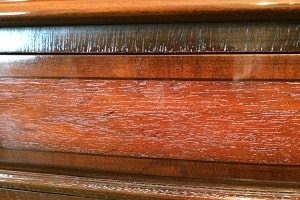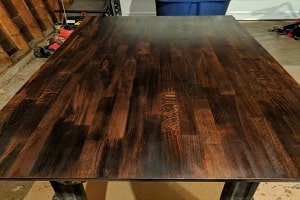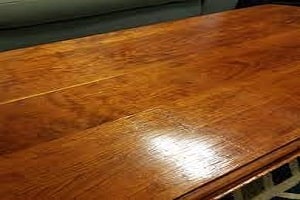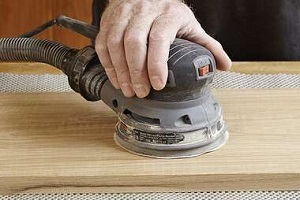Cloudy finishes may appear for a variety of reasons, including as a result of using an old product or one that has sat in a hot or cold environment. After that, adequate surface preparation is essential, which includes scraping out any old product or cleaning it and oil-free.
What if you see polyurethane cloudy after sanding? What should you do then? Read on to know the answer to the question. Along with that, we will also discuss some related topics.
After Sanding Polyurethane What Happen

After sanding polyurethane, the common rule is to apply polyurethane on the surface.
If you are using oil-based polyurethane, then the surface will be dry to touch in just two or three hours. However, you will still need to wait for at least 24 hours before applying your next coat. This is because the oil-based polyurethane needs more time to dry than water based polyurethanes.
If you are using a water based polyurethane, then the surface will be dry to touch in just one hour after applying. But you will still need to give it at least six hours to completely dry before you do anything else with it.
This means that if you have applied water-based polyurethane and want to add a second coat, then you can do that within six hours after sanding the first layer. If it has been more than six hours, then you will need to sand it once again before applying another coat of polyurethane.
This is because if water based polyurethane takes more than six hours to dry, then it will become too hard and won’t be able to absorb the new layer of poly on top of it. As a result, there will be a very thick layer of poly on top of your wooden object or floor without any absorption from
Mineral Spirits After Sanding Polyurethane

Polyurethane is a protective finish that is available in both oil-based and water-based formulas. A single coat of polyurethane will provide protection, but the best results come from two or more coats, depending on the wood and the use.
Sanding polyurethane removes the glossy finish, allowing you to change the color by re-staining or applying a different protective coating to the surface. If you choose to reapply polyurethane, you must remove all traces of dust from the sanding process before applying it; otherwise, it will appear blotchy and uneven.
You can use mineral spirits to remove the excess polyurethane. It might take a few tries to get it all off, but it will work eventually. However, you need to be careful with that. You will have problems if you use mineral spirits as a thinner for polyurethane.
It is sure that the polyurethane manufacturers would not approve of this practice. The mineral spirits will dissolve the polyurethane, but it should dry OK afterward. If you do this, make sure that the mineral spirits have evaporated before applying the next coat of polyurethane.
White Residue After Sanding Polyurethane

The white residue is possibly moisture. Polyurethane foam is a closed-cell foam, and if it absorbs moisture into the cell structure, it will not dry out completely. You can wipe the surface with a solvent such as mineral spirits or Naptha to remove the white residue and then apply more polyurethane.
But experts recommend you sand off as much of the old polyurethane as possible before applying the new coat.
How to Fix a Cloudy Polyurethane Finish

There are some polyurethane finishes that have a cloudy look. Basically, there are three things that cause polyurethane finishes to become cloudy:
- Dust in the finish as it dries
- Using a brush that leaves brush marks in the finish
- Applying multiple thin coats instead of fewer thicker ones
This type of cloudiness can be fixed by following the steps below:
Pour out some denatured alcohol into a container that has a lid on it. It is easier if you use a container with a lid because you can close it when you are done using it. Just make sure that you label it so that no one will accidentally ingest it.
Dip a rag or cloth into the denatured alcohol and wipe down the surface of your piece good. Use circular motions and apply gentle pressure to remove all of the cloudiness.
Allow it to dry for several minutes, and then check to see if there is still some cloudiness left. If there is, repeat step 2 until all of the cloudiness is gone.
How to Fix Cloudy Varnish

There are several ways to fix cloudy varnish. The first step is to figure out why it got cloudy in the first place, and the second step is to use a solution that will remove the cloudiness.
In most cases, cloudy varnish occurs either because of residue or because of moisture. Residue can come from dust or sawdust that sticks to the surface before it dries, or it can be caused by oil from your hands when you’re handling a piece of furniture. Moisture can cause the varnish to cloud up if there’s excess humidity in the air or if water gets on the varnish before it dries.
If you have cloudy varnish due to residue, you can use a tack cloth to remove residue from your project. A tack cloth is a sticky cloth that attracts dust and debris and pulls them off your project’s surface.
You can also use mineral spirits on a rag or paintbrush to wipe away oils from your hands. Then you’ll need to apply another layer of varnish after the previous layer has dried completely.
If moisture is the problem, make sure you’re working in an environment that’s warm and dry and doesn’t have high humidity levels.
Sanding Polyurethane Final Coat

Sanding the final coat of polyurethane may seem counterintuitive. After all, isn’t the whole point of the final coat to achieve a polished, smooth surface? Why sand down your work? Because it will ensure that you get that perfect finish.
The process of sanding down the final coat of polyurethane will remove any lingering dust particles or brush strokes from your surface.
There are two main approaches to sanding a final coat of polyurethane: wet sanding and dry sanding.
Wet Sanding
Wet sanding is typically done after dry sanding to get an even finish. Unlike dry sanding, wet sanding is done not to shape a surface but to remove the large scratches left by dry sanding.
Wet-sanding requires a lot of water, which means you’ll need a large bucket of clean water nearby, as well as rags or paper towels to wipe up spills. You’ll also need a sponge for applying the water and for cleaning your tools when you’re done. The wet sandpaper will clog quickly if it gets dirty, so you’ll want to keep it clean and change it often.
Wet-sanding lubricates the wood so that the abrasive particles in the paper glide over the surface rather than gouging into the wood. This gives you more control over your work and helps prevent deep scratches or gouges that will show up in the finished product.
Dry Sanding
Dry sanding is the most common method; it’s fast and doesn’t require any special equipment other than a vacuum cleaner or vent hood. But this approach has its drawbacks: Scratches from dry sanding show up more easily under the finish, which means they can be tougher to remove in the next step.
Dry dust also clogs the paper more quickly than wet dust, so you’ll have to change the paper more often if you’re working on a large surface area. Still, dry sanding is effective for its speed — it’s much faster than wet sanding when done correctly.
Sanding Polyurethane With Orbital Sander

The best thing to use while sanding polyurethane is an orbital sander. The key here is not to press while sanding. Just let the weight of the sander do the job. If you press down on the sander, you’ll dig into the flat surface that you have worked so hard to create. Sand with 180 grit, then 220 grit, if needed.
If you need to remove a lot of polyurethane, then use a belt sander but be careful not to scratch the wood too much.
Remember that when you sand, you are removing material and possibly changing the shape of your piece. One last comment: if there are any grooves or depressions in your piece, sand those before applying your first coat of polyurethane. Any imperfections will be magnified by each application of polyurethane.
How to Fix Polyurethane Mistakes
In addition to the polyurethane application process itself, mistakes can be made by using incompatible stains or finishes.
Here’s how to resolve a few common polyurethane mistakes:
Bubbling, Wrinkling, and Fish-Eyeing
These are all caused by applying polyurethane over a contaminated surface. Dust, wax, or silicone can contaminate the surface and make it impossible for the polyurethane to bond properly.
To fix these problems:
Remove the finish with a chemical stripper. Then resand and reapply the polyurethane according to the manufacturer’s instructions.
Cloudiness and Blushing
These problems occur when moisture in the air gets trapped in the finish before it dries. Cloudiness is a white haze that eventually disappears but may take several weeks of dry weather. Blushing is more serious because it causes a milky film that never goes away.
To fix these problems:
If only one coat is affected, lightly sand off the bad portions, then lightly sand with 220 grit paper before applying another coat of polyurethane. If more than one coat has been affected, completely strip off all coats of finish and start over from scratch.
Read more to learn on Can you put polyurethane over Polycrylic?
Frequently Asking Question
1. How Do I Remove a Cloudy Polyurethane Finish?
You can remove cloudy polyurethane from your wood project by lightly sanding the surface with fine-grit sandpaper and then reapplying a fresh coat of polyurethane. In some cases, you may be able to reduce the cloudiness, but if the wood is bleached or discolored, removing the cloudy finish won’t help much.
2. Why Is My Polyurethane Coating Cloudy?
Cloudy polyurethane is typically caused by applying the finish too quickly or in too cold of temperatures. The best way to fix it is to strip off the current finish, lightly sand the surface, then apply a new coat of varnish once you have thoroughly cleaned the piece.
3. Can You Sand Between Coats of Polyurethane?
Yes, you can sand between layers of polyurethane as long as each coat has dried completely (typically 24 hours for water based and 48 hours for oil-based). You can use 220 fine-grit sandpaper and lightly sand in between coats to ensure an even application on your final coat.
4. How to Fix Uneven Polyurethane Finish?
Apply the stain and finish to the top in even, thin layers, using a clean cloth for each layer. Sand each layer with fine-grit sandpaper, then apply an additional coat. After the final coat of polyurethane is applied, sand lightly with very fine sandpaper (400 to 600 grit) for a perfectly smooth finish.
5. How Do You Fix Cloudy Polyurethane?
There are several tricks to fixing your cloudy wood finish, including using mineral spirits, sanding, or applying a fresh coat of polyurethane. You can also fix it by switching to a different type of polyurethane, such as satin or semi-gloss. If none of these remedies work, you may have to strip down the piece and start over with a clear coat.
6. Why Is My Polyurethane Cloudy After Sanding?
Cloudiness can occur after sanding because dust particles from the sanding are trapped in the polyurethane and appear as white spots or clouds when dry. You can remove this cloudiness by wiping down the surface with mineral spirits and then reapplying a top coat of polyurethane.
7. How Do You Clean Polyurethane After Sanding?
Use mineral spirits to clean up after applying the first few coats of polyurethane. Once the finish is dry, you can use a damp towel to wipe off dust before applying additional coats.
8. Can You Use a Torch to Get Bubbles Out of Polyurethane
Sanding between coats is not required, but it will provide a better finish. If you are applying a second coat within 4-8 hours, use a quick-drying polyurethane instead of waiting for the first coat to dry. Lightly sanding produces a smoother result, but it is not necessary.
Conclusion
At this point, you already know what happens if polyurethane is cloudy after sanding. In short, the first coat of polyurethane must be very thin to avoid puddling. The second coat should be thicker and should seal the floor properly.
After sanding the surface with 120 grit sandpaper, it is necessary to remove the dust with a damp cloth before applying the third coat of polyurethane. If you want to add more coats for additional protection or glossiness, you must wait at least 24 hours before repeating.

